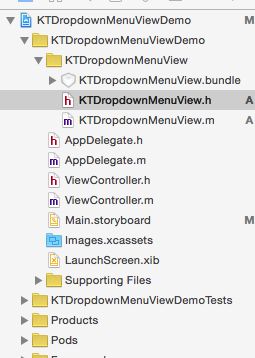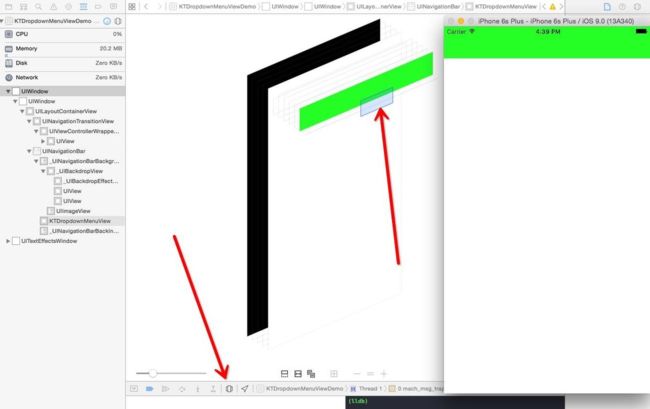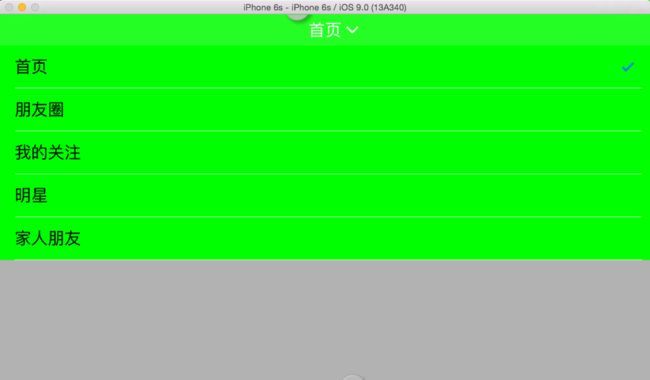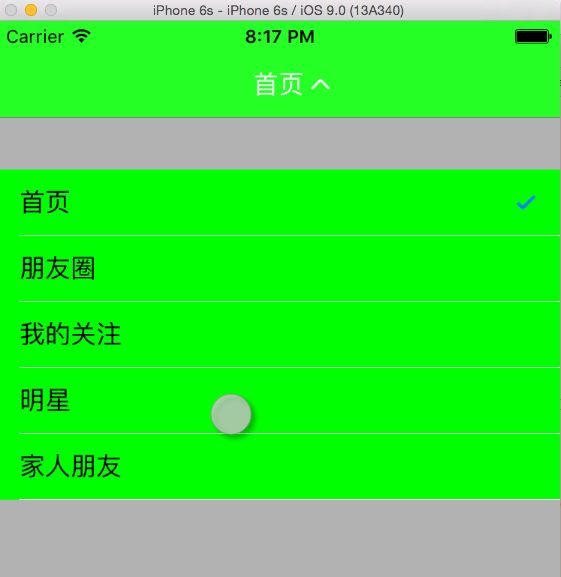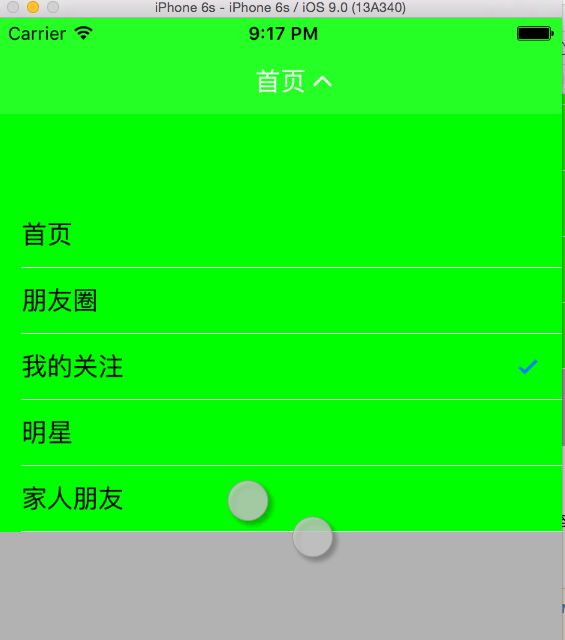之前看到一个swift开源项目BTNavigationDropdownMenu, 就是一个类似新浪微博的下拉式导航菜单,看看下面的效果:
之前看这个项目的时候(现在作者已经更新到适配横竖屏切换了!用的UIViewAutoResizingMask),不能支持横竖屏切换,而且没有Objective-C版本,于是自己用Objective-C重新写了一个,并且加上Masonry做自动布局适配屏幕切换,做一遍下来加深自己对View层次和自动布局的理解。写下来适合新手看看,高手就绕道吧,不啰嗦了,开始吧。。。
1、新建项目,盗用BTNavigationDropdownMenu的图标元素bundle到我的自己的项目下面。继承UIView创建KTDropdownMenuView。配置CocoaPods,引入Masonry:
pod "Masonry"
2、添加一些基本的设置属性和初始化方法,不够的可以以后再添加
#import
@interface KTDropdownMenuView : UIView
// cell color default greenColor
@property (nonatomic, strong) UIColor *cellColor;
// cell seprator color default whiteColor
@property (nonatomic, strong) UIColor *cellSeparatorColor;
// cell height default 44
@property (nonatomic, assign) CGFloat cellHeight;
// animation duration default 0.4
@property (nonatomic, assign) CGFloat animationDuration;
// text color default whiteColor
@property (nonatomic, strong) UIColor *textColor;
// text font default system 17
@property (nonatomic, strong) UIFont *textFont;
// background opacity default 0.3
@property (nonatomic, assign) CGFloat backgroundAlpha;
- (instancetype)initWithFrame:(CGRect)frame titles:(NSArray*)titles;
@end
3、在m文件中定义私有属性titles,顾名思义这个存放菜单名称的数组,初始化前面的默认值。个人喜欢用getter来实现懒加载,代码风格而已,看个人喜好,下面是代码:
#import "KTDropdownMenuView.h"
#import
@interface KTDropdownMenuView()
@property (nonatomic, copy) NSArray *titles;
@end
@implementation KTDropdownMenuView
#pragma mark -- life cycle --
- (instancetype)initWithFrame:(CGRect)frame titles:(NSArray *)titles
{
if (self = [super initWithFrame:frame])
{
_animationDuration=0.4;
_backgroundAlpha=0.3;
_cellHeight=44;
_selectedIndex = 0;
_titles= titles;
}
return self;
}
#pragma mark -- getter and setter --
- (UIColor *)cellColor
{
if (!_cellColor)
{
_cellColor = [UIColor greenColor];
}
return _cellColor;
}
- (UIColor *)cellSeparatorColor
{
if (!_cellSeparatorColor)
{
_cellSeparatorColor = [UIColor whiteColor];
}
return _cellSeparatorColor;
}
- (UIColor *)textColor
{
if (!_textColor)
{
_textColor = [UIColor whiteColor];
}
return _textColor;
}
- (UIFont *)textFont
{
if(!_textFont)
{
_textFont = [UIFont systemFontOfSize:17];
}
return _textFont;
}
4、在ViewController中加上如下代码:
[self.navigationController.navigationBar setBarTintColor:[UIColor greenColor]];
KTDropdownMenuView *menuView = [[KTDropdownMenuView alloc] initWithFrame:CGRectMake(0,0,100,44) titles:@[@"首页",@"朋友圈",@"我的关注",@"明星",@"家人朋友"]];
self.navigationItem.titleView = menuView;
self.navigationItem.titleView = menuView的作用是替换当前的titleView为我们自定义的view。运行一下,除了导航栏变绿之外,并没有什么卵用。但是,运用Xcode的视图调试功能,你会发现还是有点卵用的:
转动一下,导航栏上有个View出现了有木有!只是menuView没有颜色导致你看不见而已。
5、好,下面开始在我们的View上添加控件了,首先导航栏上面有一个可以点的button,同时右边有一个箭头是吧。在m文件中加上如下控件
@property (nonatomic, strong) UIButton *titleButton;
@property (nonatomic, strong) UIImageView *arrowImageView;
同时写下getter
- (UIButton *)titleButton
{
if (!_titleButton)
{
_titleButton = [[UIButton alloc] init];
[_titleButton setTitle:[self.titles objectAtIndex:0] forState:UIControlStateNormal];
[_titleButton addTarget:self action:@selector(handleTapOnTitleButton:) forControlEvents:UIControlEventTouchUpInside];
[_titleButton.titleLabel setFont:self.textFont];
[_titleButton setTitleColor:self.textColor forState:UIControlStateNormal];
}
return _titleButton;
}
- (UIImageView *)arrowImageView
{
if (!_arrowImageView)
{
NSString * bundlePath = [[ NSBundle mainBundle] pathForResource:@"KTDropdownMenuView" ofType:@ "bundle"];
NSString *imgPath= [bundlePath stringByAppendingPathComponent:@"arrow_down_icon.png"];
UIImage *image=[UIImage imageWithContentsOfFile:imgPath];
_arrowImageView = [[UIImageView alloc] initWithImage:image];
}
return _arrowImageView;
}
接下来当然是addSubView添加到view中:-(instancetype)initWithFrame:(CGRect)frame titles:(NSArray *)titles方法中写下:
[self addSubview:self.titleButton];
[self addSubview:self.arrowImageView];
运行你会发现button和imageView的大小和位置显然不是你想的那样,因为我们并没有设置控件的位置。Masonry该出马了,上代码:
[self.titleButton mas_makeConstraints:^(MASConstraintMaker *make) {
make.center.equalTo(self);
}];
[self.arrowImageView mas_makeConstraints:^(MASConstraintMaker *make) {
make.left.equalTo(self.titleButton.mas_right).offset(5);
make.centerY.equalTo(self.titleButton.mas_centerY);
}];
Masonry使用非常简单,就简单的三个方法,mas_makeConstraints, mas_remakeConstraints, mas_updateConstraints来进行约束的管理, 比起用原生方法写一堆的布局代码简单太多。强烈推荐喜欢用代码写View的童鞋使用Masonry来进行约束布局。关于Masonry的更详细用法可以去https://github.com/SnapKit/Masonry 上查看。
上面的代码很容易理解,第一个约束语句是让titleButton处于视图的中间位置。第二个约束语句是让arrowImageView保持与titleButton水平中心对齐,同时arrowImageView的左边与titleButton的右边水平距离为5。
Masonry使用链式语法让添加约束变得非常简单,要是你自己用苹果的原生API,你得写一堆的代码来实现布局。比如下面这样又臭又长,还容易出错。另外一点就是Masonry的语法非常易读,上面的几行代码从左往右阅读,毫不费力。
[superview addConstraints:@[
//view1 constraints
[NSLayoutConstraint constraintWithItem:view1 attribute:NSLayoutAttributeTop
relatedBy:NSLayoutRelationEqual
toItem:superview
attribute:NSLayoutAttributeTop
multiplier:1.0
constant:padding.top],
[NSLayoutConstraint constraintWithItem:view1 attribute:NSLayoutAttributeLeft
relatedBy:NSLayoutRelationEqual
toItem:superview
attribute:NSLayoutAttributeLeft
multiplier:1.0
constant:padding.left],
[NSLayoutConstraint constraintWithItem:view1 attribute:NSLayoutAttributeBottom
relatedBy:NSLayoutRelationEqual
toItem:superview
attribute:NSLayoutAttributeBottom
multiplier:1.0
constant:-padding.bottom],
[NSLayoutConstraint constraintWithItem:view1 attribute:NSLayoutAttributeRight
relatedBy:NSLayoutRelationEqual
toItem:superview attribute:NSLayoutAttributeRight
multiplier:1
constant:-padding.right]]
];
运行之后,果然,使我们预料的效果哈
细心的会发现我用Masonry的时候并没有设置arrowImageView与titleButton的size,但是照样运行地很好。这是因为自动布局系统中,如果你没有设置控件的size,那么就会默认使用固有内容大小(Intrinsic Content Size),固有内容会驱动设置控件的size。实际上Xcode里面大部分的控件都有Intrinsic Content Size。也就是说如果你内容多的时候,size会自动变大,反之内容少的时候,size会自动变小。自动布局的Intrinsic Content Size这个特性在本地化不同语言(内容长度不一致)的时候非常有用。比如用一个label显示中文的时候,可能就两个字很短,但是翻译成英文变成一大串,这时候使用自动布局,不要手动去设置label的size,自动布局会自动设置好label所需的size。
6、下面添加tableView,加上如下属性。tableView是用来装载文字菜单列表的;backgroundView是后面的一层半透明的黑色背景,当tableView出现的时候,backgroundView也出现,菜单收起的时候一起消失;wrapperView则是tableView和backgroundView的父View。
@property (nonatomic, strong) UITableView *tableView;
@property (nonatomic, strong) UIView *backgroundView;
@property (nonatomic, strong) UIView *wrapperView;
那么问题来了,wrapperView附着到哪里?显然不能加在KTDropdownMenuView上哈,答案是附着到当前的keyWindow上面。因为初始化的过程中并没有传入其他的View,而且也不应该让KTDropdownMenuView与其他的view产生关联,否则KTDropdownMenuView会随着其他view的消失而消失。直接添加到keyWindow上面,即可以显示在最上层。
另外一个问题是wrapperView的大小位置如何设置?如何保证旋转屏幕也能适配大小?利用自动布局可以适配旋转屏幕,同时wrapperView要在导航栏下面显示。那么很容易想到wrapperView的top要依靠在导航栏的bottom,同时左,右,下需要与当前keyWindow分别对齐。
那么问题又来了,如何找到导航栏navigationBar?初始化方法并没有传进来啊。。。当然简单的办法在初始化方法里面传一个进来,这里用BTNavigationDropdownMenu的思路,递归搜索最前面的UINavigationController,然后获取navigationBar,代码贴上来,自己理解。。。
@implementation UIViewController (topestViewController)
- (UIViewController *)topestViewController
{
if (self.presentedViewController)
{
return [self.presentedViewController topestViewController];
}
if ([self isKindOfClass:[UITabBarController class]])
{
UITabBarController *tab = (UITabBarController *)self;
return [[tab selectedViewController] topestViewController];
}
if ([self isKindOfClass:[UINavigationController class]])
{
UINavigationController *nav = (UINavigationController *)self;
return [[nav visibleViewController] topestViewController];
}
return self;
}
@end
下面在初始化方法中加上如下代码:
UIWindow *keyWindow = [UIApplication sharedApplication].keyWindow;
UINavigationBar *navBar = [keyWindow.rootViewController topestViewController].navigationController.navigationBar;
[keyWindow addSubview:self.wrapperView];
[self.wrapperView mas_makeConstraints:^(MASConstraintMaker *make) {
make.left.right.bottom.equalTo(keyWindow);
make.top.equalTo(navBar.mas_bottom);
}];
[self.wrapperView addSubview:self.backgroundView];
[self.backgroundView mas_makeConstraints:^(MASConstraintMaker *make) {
make.edges.equalTo(self.wrapperView);
}];
[self.wrapperView addSubview:self.tableView];
[self.tableView mas_makeConstraints:^(MASConstraintMaker *make) {
make.edges.equalTo(self.wrapperView);
}];
以上略掉tableViewDataSource的相关代码和getter。
wrapperView的布局代码,如前面分析的一样:wrapperView的top要对其导航栏的bottom,同时左,右,下需要与当前keyWindow分别对齐。那么在屏幕旋转的时候,keyWindow和导航栏也会旋转(系统帮你做的),wrapperView要保持约束关系不变,也会自动跟着旋转,这就是为什么自动布局能适应屏幕旋转的原因。
make.left.right.bottom.equalTo(keyWindow);
make.top.equalTo(navBar.mas_bottom);
运行一下:
旋转一下,自动布局工作的很好,能自动适应屏幕旋转。
7、下面加上按钮响应和动画,添加下面两个属性:
@property (nonatomic, assign) BOOL isMenuShow;
@property (nonatomic, assign) NSUInteger selectedIndex;
然后实现按钮的点击事件方法,实现tableView的delegate方法:
#pragma mark -- UITableViewDataDelegate --
- (void)tableView:(UITableView *)tableView didSelectRowAtIndexPath:(NSIndexPath *)indexPath
{
self.selectedIndex = indexPath.row;
[tableView deselectRowAtIndexPath:indexPath animated:YES];
}
#pragma mark -- handle actions --
- (void)handleTapOnTitleButton:(UIButton *)button
{
self.isMenuShow = !self.isMenuShow;
}
相应的属性setter
- (void)setIsMenuShow:(BOOL)isMenuShow
{
if (_isMenuShow != isMenuShow)
{
_isMenuShow = isMenuShow;
if (isMenuShow)
{
[self showMenu];
}
else
{
[self hideMenu];
}
}
}
- (void)setSelectedIndex:(NSUInteger)selectedIndex
{
if (_selectedIndex != selectedIndex)
{
_selectedIndex = selectedIndex;
[_titleButton setTitle:[_titles objectAtIndex:selectedIndex] forState:UIControlStateNormal];
[self.tableView reloadData];
}
self.isMenuShow = NO;
}
在实现动画方法showMenu和hideMenu之前,先考虑:这个tableView在出现的时候是从上往下出现的,也就是这个tableView出现前它的bottom应该在wrapperView的top上面,并且要被挡住不能被看见(被挡住很简单,设置wrapperView的clipsToBounds为YES,它的subView在超出边界的时候自动会被挡住)。于是先修改init方法中设置tableView起始位置的代码:
CGFloat tableCellsHeight = _cellHeight * _titles.count;
[self.tableView mas_makeConstraints:^(MASConstraintMaker *make) {
make.left.right.equalTo(self.wrapperView);
make.top.equalTo(self.wrapperView.mas_top).offset(-tableCellsHeight);
make.bottom.equalTo(self.wrapperView.mas_bottom).offset(tableCellsHeight);
}];
[self.tableView layoutIfNeeded];
self.wrapperView.hidden = YES;
注意到最后加了一句 [self.tableView layoutIfNeeded],这是因为自动布局动画都是驱动layoutIfNeeded来实现的,与以往的设置frame不一样。给View添加或者更新约束后,并不能马上看到效果,而是要等到view layout的时候触发,layoutIfNeeded就是手动触发这一过程。这里为了与后面的动画不冲突,首先调用一次,设置初始状态,下面是动画代码:
- (void)showMenu
{
[self.tableView mas_updateConstraints:^(MASConstraintMaker *make) {
make.edges.equalTo(self.wrapperView);
}];
self.wrapperView.hidden = NO;
self.backgroundView.alpha = 0.0;
[UIView animateWithDuration:self.animationDuration
animations:^{
self.arrowImageView.transform = CGAffineTransformRotate(self.arrowImageView.transform, M_PI);
}];
[UIView animateWithDuration:self.animationDuration * 1.5
delay:0
usingSpringWithDamping:0.7
initialSpringVelocity:0.5
options:UIViewAnimationOptionCurveLinear
animations:^{
[self.tableView layoutIfNeeded];
self.backgroundView.alpha = self.backgroundAlpha;
} completion:nil];
}
- (void)hideMenu
{
CGFloat tableCellsHeight = _cellHeight * _titles.count;
[self.tableView mas_updateConstraints:^(MASConstraintMaker *make) {
make.left.right.equalTo(self.wrapperView);
make.top.equalTo(self.wrapperView.mas_top).offset(-tableCellsHeight);
make.bottom.equalTo(self.wrapperView.mas_bottom).offset(tableCellsHeight);
}];
[UIView animateWithDuration:self.animationDuration
animations:^{
self.arrowImageView.transform = CGAffineTransformRotate(self.arrowImageView.transform, M_PI);
}];
[UIView animateWithDuration:self.animationDuration * 1.5
delay:0
usingSpringWithDamping:0.7
initialSpringVelocity:0.5
options:UIViewAnimationOptionCurveLinear
animations:^{
[self.tableView layoutIfNeeded];
self.backgroundView.alpha = 0.0;
} completion:^(BOOL finished) {
self.wrapperView.hidden = YES;
}];
}
代码很简单,主要是设置动画之后的tableView约束位置,旋转arrowImageView同时改变backgroundView的透明度,注意这里是调用的mas_updateConstraints是更新约束,一搬做动画都是用这个。但是细心的话会发现有一个bug,动画过程中,还有把tableView往下面拽的时候,上面和导航栏之间会出现灰色背景啊。
不能忍,添加一个与tableCell一样颜色的tableHeaderView到tableView上面,在showMenu方法的开头加上下面代码:
UIView *headerView = [[UIView alloc] initWithFrame:CGRectMake(0, 0, 0, kKTDropdownMenuViewHeaderHeight)];
headerView.backgroundColor = self.cellColor;
self.tableView.tableHeaderView = headerView;
其中kKTDropdownMenuViewHeaderHeight设置为300。值得注意的是,这里并不需要设置tableHeaderView的宽度,它会自适应到tableView的宽度。还有加了tableHeaderView之后,相应的mas_updateConstraints和mas_makeConstraints方法中需要将位置上移kKTDropdownMenuViewHeaderHeight的距离。同时把init方法中的[self.tableView layoutIfNeeded]移动到添加tableHeaderView之后。现在动画或者拖拽的时候不会看到丑陋的背景了。
完整的项目在这里,https://github.com/tujinqiu/KTDropdownMenuView
欢迎讨论交流,批评指正!!!

